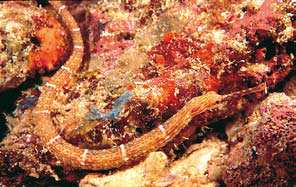SYNGNATHIDAE
Pipefishes (Seahorses)
By Ukkrit Satapoomin
|
Usually small fishes, 4-50 cm TL. Body slender and elongate, without scales, encased in a series of bony rings. Head either along same axis as rest of body (subfamily Syngnathinae) or bent in ventral direction from main body axis (subfamily Hippocampinae). Snout long and tubular; mouth small, toothless, located at tip of snout. Gill openings reduced to a pore in the opercular membrane. Branchiostegal rays 1-3. Dorsal fin single, without spine, usually with 15-60 soft rays; anal fin very small, with 2-6 soft rays; caudal fin, if present, with 8-10 rays; pectoral fins usually with 10-23 rays; pelvic fins absent. Adults of some species may lack dorsal, anal, and pectoral fins. Caudal peduncle may be prehensile. Lateral line absent. Color: variable with the species, generally adapted to preferred habitat; species living on seagrass, sand, and coral rubble usually have grey, green, brown, or black ground color with various patterns; coral-reef species sometimes colorful with white, yellow, orange, blue, red, and black stripes and bands. Similar families occurring in the area. Aulostomidae: larger; body compressed, elongate, and scaly; distinct separate dorsal fin spines, followed by a normal second dorsal fin; caudal fin well developed; lateral line present. Fistulariidae: larger; body depressed rather than compressed; elongate, and naked, or with minute prickles and linear row of scutes; caudal fin forked with a distinct elongate filament. Solenostomidae: body short, compressed, with large stellate bony plates; 2 separate dorsal fins, pelvic fins relatively large, modified into brood pouch in females. Remarks. Usually limited to shallow water at depth of 1 to more than 100 m. Feed on minute benthic and planktonic fauna, preferably microcrustaceans, by sucking into a tubular snout. Males have a brood pouch in which the eggs are laid and where they are fertilized and incubated. |

|
|








